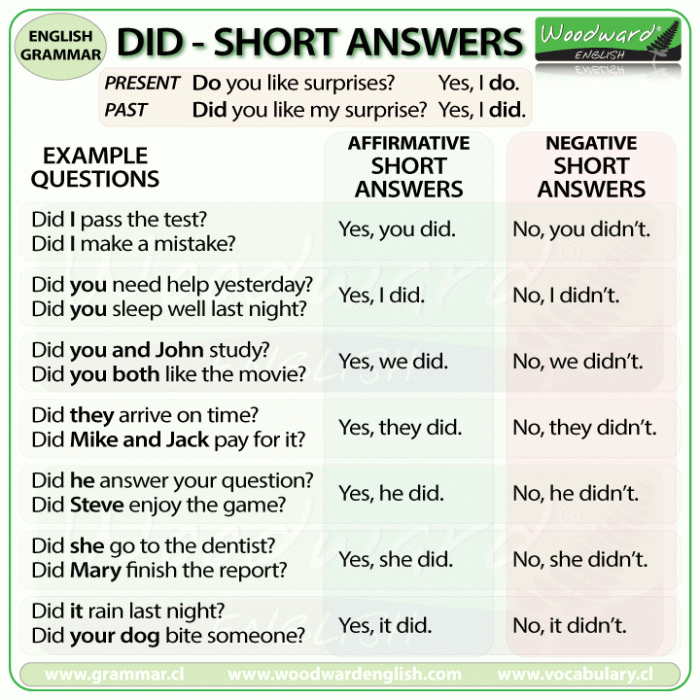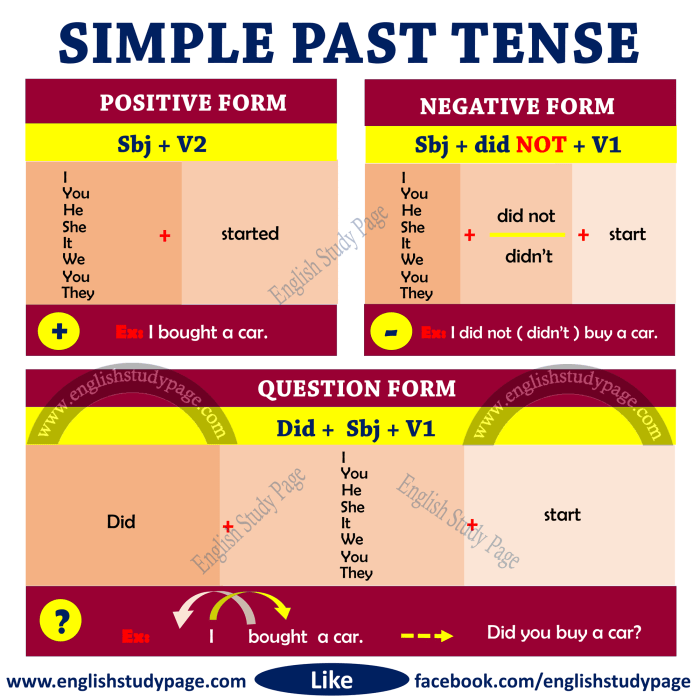Embark on an enlightening journey into the realm of passé composé questions and answers, where the intricacies of French past tense unravel before your very eyes. This comprehensive guide unveils the secrets of forming past participles, employing auxiliary verbs, and navigating agreement and negation with precision.
Prepare to delve into a world of linguistic mastery, unraveling the mysteries of French grammar with unparalleled clarity and finesse.
As we delve deeper into the nuances of passé composé, we will uncover the common time expressions that bring the past to life and explore the pitfalls that await the unwary. With practice exercises meticulously crafted to reinforce your understanding, you will emerge as a confident master of this essential French tense, ready to communicate your past experiences with eloquence and accuracy.
Past Participle Formation

The past participle is a verb form that is used to form the passé composé, a past tense in French. It is also used in other grammatical constructions, such as the passive voice and the pluperfect tense.
Regular Verbs
For regular verbs, the past participle is formed by adding the following endings to the verb stem:
- -é for verbs ending in -er
- -i for verbs ending in -ir
- -u for verbs ending in -re
For example, the past participle of parler (to speak) is parlé, the past participle of finir (to finish) is fini, and the past participle of vendre (to sell) is vendu.
Irregular Verbs
For irregular verbs, the past participle is formed in a variety of ways. Some common irregular past participles include:
| Verb | Past Participle |
|---|---|
| être (to be) | été |
| avoir (to have) | eu |
| faire (to do) | fait |
| dire (to say) | dit |
| voir (to see) | vu |
Auxiliary Verbs
In French, the passé composé is a compound tense used to describe past actions or events. It is formed using an auxiliary verb (avoir or être) followed by the past participle of the main verb.
Using Avoir as an Auxiliary Verb
The auxiliary verb avoir is used with most verbs in the passé composé. It is conjugated according to the subject of the sentence and placed before the past participle of the main verb.
- Example:Je aiparlé à Marie hier.
Using Être as an Auxiliary Verb
The auxiliary verb être is used with a specific group of verbs known as intransitive verbs. These verbs typically describe movement, change of state, or perception.
- Example:Je suisallé au cinéma hier.
Rules for Using Avoir and Être
The following table summarizes the rules for using avoir and être as auxiliary verbs in the passé composé:
| Verb Type | Auxiliary Verb |
|---|---|
| Transitive verbs (verbs that take a direct object) | Avoir |
| Intransitive verbs (verbs that do not take a direct object) | Être |
| Reflexive verbs (verbs that are reflexive) | Être |
| Verbs that describe a change of state or perception | Être |
Agreement of the Past Participle: Passé Composé Questions And Answers
In French, the past participle must agree in gender and number with the subject of the sentence. This means that the ending of the past participle will change depending on whether the subject is masculine or feminine, singular or plural.
Rules for Agreement
- If the subject is masculine singular, the past participle will end in -é.
- If the subject is feminine singular, the past participle will end in -ée.
- If the subject is masculine plural, the past participle will end in -és.
- If the subject is feminine plural, the past participle will end in -ées.
Examples
- Le garçon a mangé une pomme. (The boy ate an apple.)
- La fille a mangé une pomme. (The girl ate an apple.)
- Les garçons ont mangé des pommes. (The boys ate apples.)
- Les filles ont mangé des pommes. (The girls ate apples.)
Negation and Interrogation

In the passé composé, negation is expressed by placing the negative particle nebefore the auxiliary verb and pasafter it. Interrogative sentences are formed by inverting the subject and the auxiliary verb.
Negation
To negate a sentence in the passé composé, follow these steps:
- Place the negative particle nebefore the auxiliary verb.
- Place the negative particle pasafter the auxiliary verb.
For example:
J’ai mangé.(I ate.) Je n’ai pas mangé.(I did not eat.)
Interrogation
To form an interrogative sentence in the passé composé, follow these steps:
- Invert the subject and the auxiliary verb.
- Place the question mark at the end of the sentence.
For example:
Tu as fini.(You finished.) As-tu fini ?(Did you finish?)
Time Expressions

The passé composé is commonly used with a variety of time expressions to indicate when an action or event took place. These expressions can be divided into several categories, including:
Specific Time Expressions
Specific time expressions refer to a particular point in time. These include:
- Yesterday (hier)
- Last week (la semaine dernière)
- Last month (le mois dernier)
- Last year (l’année dernière)
- On Monday (lundi)
- At 10 o’clock (à 10 heures)
Example:
Je suis allé au cinéma hier.
I went to the cinema yesterday.
Indefinite Time Expressions
Indefinite time expressions refer to a general period of time. These include:
- Recently (récemment)
- Lately (dernièrement)
- A few days ago (il y a quelques jours)
- A long time ago (il y a longtemps)
- Never (jamais)
Example:
J’ai vu ce film récemment.
I saw this movie recently.
Time Expressions with “Depuis”
“Depuis” means “since” and is used to indicate the start of a period of time that continues up to the present. These include:
- Since yesterday (depuis hier)
- Since last week (depuis la semaine dernière)
- Since last month (depuis le mois dernier)
- Since last year (depuis l’année dernière)
- Since Monday (depuis lundi)
- Since 10 o’clock (depuis 10 heures)
Example:
Je suis en vacances depuis hier.
I have been on vacation since yesterday.
Time Expressions with “Pendant”
“Pendant” means “during” and is used to indicate the duration of a period of time. These include:
- During the day (pendant la journée)
- During the week (pendant la semaine)
- During the month (pendant le mois)
- During the year (pendant l’année)
- During the weekend (pendant le week-end)
Example:
J’ai travaillé pendant toute la journée.
I worked all day.
Common Mistakes
When using the passé composé, several common mistakes can occur. These mistakes often stem from misunderstandings about the tense’s formation or usage.
To avoid these mistakes, it is essential to understand the rules governing the passé composé and to practice using it correctly.
Incorrect Auxiliary Verb Usage
- Incorrect:J’ai mangé la pizza hier soir.
- Correct:J’ai mangé la pizza hier soir.
In the incorrect example, the auxiliary verb “avoir” is used with the past participle of “manger,” which is incorrect. The correct auxiliary verb for the first person singular is “être.”
Incorrect Agreement of the Past Participle
- Incorrect:Nous avons parlés français.
- Correct:Nous avons parlé français.
In the incorrect example, the past participle “parlés” is not correctly agreed with the subject “nous.” The correct past participle for the plural subject is “parlé.”
Negation Errors
- Incorrect:Je n’ai pas mangé pas la pizza.
- Correct:Je n’ai pas mangé la pizza.
In the incorrect example, the negation is incorrectly placed. The correct placement of the negation is immediately before the past participle.
Incorrect Time Expressions
- Incorrect:J’ai mangé la pizza ce matin.
- Correct:J’ai mangé la pizza hier matin.
In the incorrect example, the time expression “ce matin” is incorrectly used with the passé composé. The passé composé is used to express actions that occurred in the past, so the time expression should indicate a past time.
Practice Exercises
To reinforce understanding of the passé composé, a comprehensive set of practice exercises is essential. These exercises are designed to cater to diverse learning styles and provide ample opportunities for students to apply their knowledge in various contexts.
The exercises encompass a range of formats, including fill-in-the-blank, translation, and conversation practice. Each exercise type serves a specific purpose in solidifying students’ grasp of the passé composé’s formation, usage, and nuances.
Fill-in-the-Blank Exercises, Passé composé questions and answers
Fill-in-the-blank exercises require students to complete sentences by selecting the correct form of the passé composé. This format allows students to focus on the specific verb form and its agreement with the subject. It also helps them identify common irregular past participles.
Translation Exercises
Translation exercises involve translating sentences from English to French or vice versa. By translating sentences that utilize the passé composé, students can develop a deeper understanding of its usage in different contexts and improve their overall language proficiency.
Conversation Practice
Conversation practice provides a dynamic and interactive way for students to use the passé composé in real-life situations. By engaging in conversations that incorporate the past tense, students can enhance their fluency and natural use of the language.
Question Bank
What is the difference between avoir and être as auxiliary verbs in passé composé?
Avoir is used with transitive verbs (verbs that take a direct object), while être is used with intransitive verbs (verbs that do not take a direct object) and certain reflexive verbs.
How do I agree the past participle with the subject of the sentence?
The past participle agrees in gender and number with the subject of the sentence.
How do I form negative and interrogative sentences in passé composé?
To form a negative sentence, place ne before the auxiliary verb and pas after it. To form an interrogative sentence, invert the subject and the auxiliary verb.